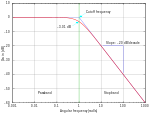Ficheiro:Butterworth response.png

Dimensões desta antevisão: 800 × 568 píxeis. Outras resoluções: 320 × 227 píxeis | 640 × 454 píxeis | 1 024 × 727 píxeis | 1 240 × 880 píxeis.
Imagem numa resolução maior (1 240 × 880 píxeis, tamanho: 86 kB, tipo MIME: image/png)
Histórico do ficheiro
Clique uma data e hora para ver o ficheiro tal como ele se encontrava nessa altura.
| Data e hora | Miniatura | Dimensões | Utilizador | Comentário | |
|---|---|---|---|---|---|
| atual | 17h45min de 23 de julho de 2005 |  | 1 240 × 880 (86 kB) | Omegatron | split the cutoff frequency markers |
| 16h31min de 23 de julho de 2005 |  | 1 250 × 880 (92 kB) | Omegatron | Better butterworth filter response curve | |
| 19h54min de 26 de junho de 2005 |  | 250 × 220 (2 kB) | Omegatron | A graph or diagram made by User:Omegatron. (Uploaded with Wikimedia Commons.) Source: Created by User:Omegatron {{GFDL}}{{cc-by-sa-2.0}} Category:Diagrams\ |
Utilização local do ficheiro
As seguintes 3 páginas usam este ficheiro:
Utilização global do ficheiro
As seguintes wikis usam este ficheiro:
- be-tarask.wikipedia.org
- de.wikipedia.org
- eo.wikipedia.org
- et.wikipedia.org
- fr.wikipedia.org
- hi.wikipedia.org
- it.wikipedia.org
- ja.wikipedia.org
- pl.wikipedia.org
- zh.wikipedia.org







